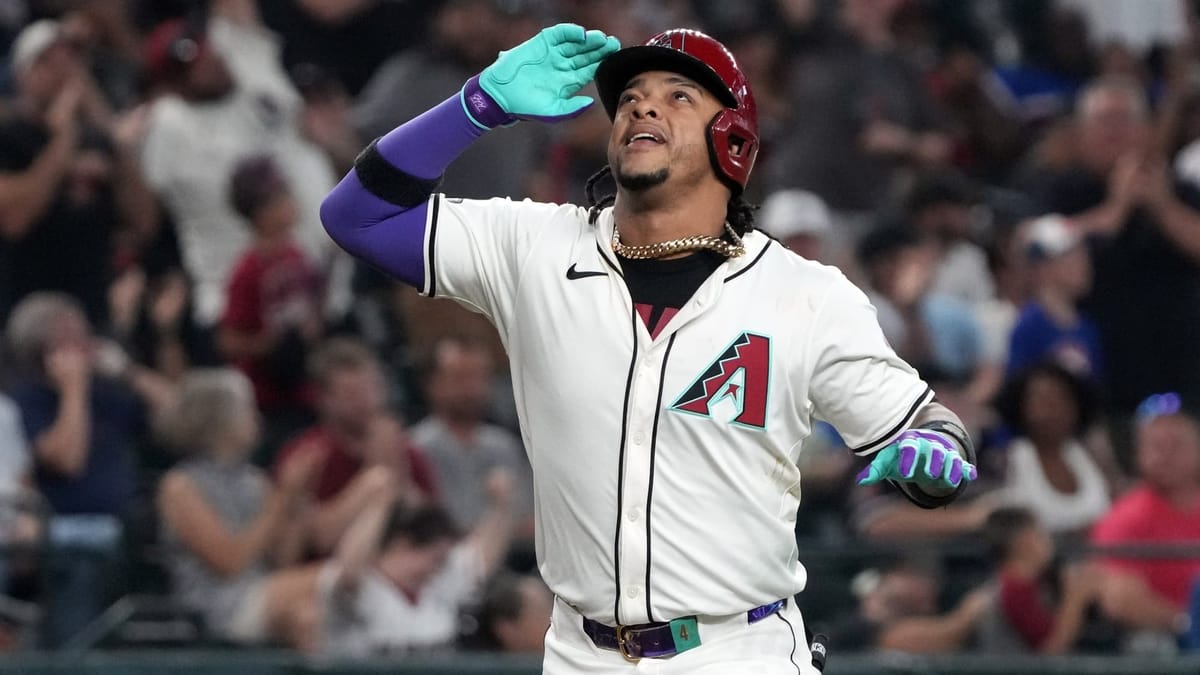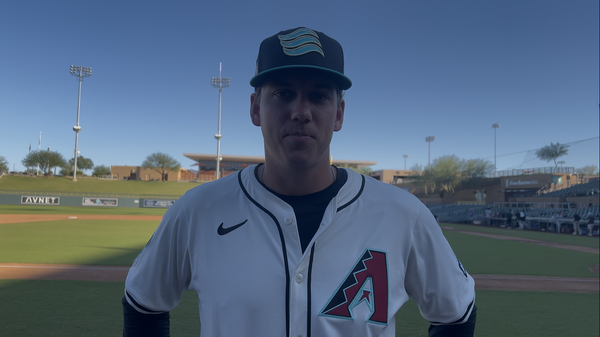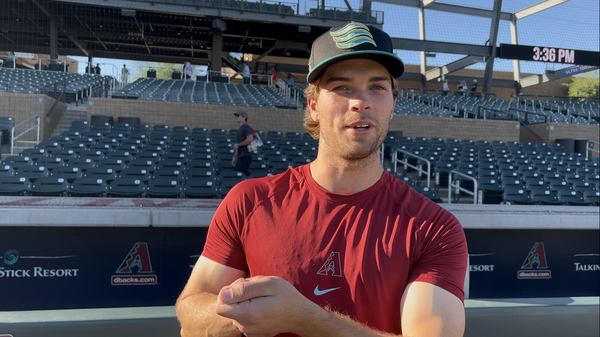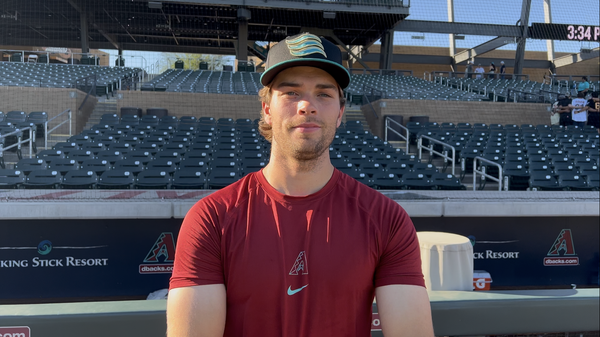D-backs' Infield Shakeup Could Define the Next Era
Only Geraldo Perdomo is locked in at shortstop long-term. Everyone else? On the move, up for grabs, or fighting to prove they belong.

Over the next year, the D-backs’ infield will see sweeping changes. Only Geraldo Perdomo is locked in at shortstop long-term. Everyone else? On the move, up for grabs, or fighting to prove they belong.
Even if they won't admit it outright, the D-backs are in a soft rebuild they hope to finish by the end of the 2026 season. Most of their impact arms in 2025 are on the shelf with major injuries. While they wait for Corbin Burnes and Justin Martinez to finish their recovery from Tommy John surgery, they can sort out the rest of the roster and compete for a title again starting in 2027.
Other than the pitching staff, the biggest changes will happen on the infield. Three of the four spots are expected to see major changes by the time their next contention window opens. That's the area where their farm system is strongest and likely to carry the team through their next contention window. We'll have a strong
We'll examine the outlook at each of the three positions and the players competing for those jobs.
First Base: Tyler Locklear's Job to Lose
The D-backs are putting a lot of faith in Locklear as their solution at first base. Acquired as the centerpiece in the Eugenio Suárez trade, along with pitchers Hunter Cranton and Juan Burgos, they're expecting him to play a key role in their lineup for the next window. He is one of six prospects who should get a thorough evaluation in the final two months of the season.
For the past decade-plus, Arizona has been spoiled by high-quality first basemen who could hit 30 homers, drive in 100 runs, and play Gold Glove caliber defense. The best-case scenario for Locklear is that he can hopefully grow into that type of bat while playing acceptable levels of defense.
The runway for Locklear is going to be the end of the 2026 season. That's when Groover will be banging on the door for a big league opportunity. Between the two prospects, the D-backs are in a much better position for contending if Locklear hits his offensive ceiling. Even with a weaker hit tool, he has a larger power ceiling, and there will be a need for a 30-homer bat that can drive in 100 runs in the middle of their lineup.
With a long runway ahead of him, the focus for Locklear should be more on process rather than results. The key for him is improving his swing decisions and generating loud contact more often. The long-term goal is for him to assume the Christian Walker mantle as the primary run-producer in the lineup.
The key metrics to monitor will be chase rate, whiff rate, zone contact%, hard-hit%, and pull air%. Fortunately, those are all publicly available on his Statcast page, so you'll be able to track along with me. However, it's important to note he has only 43 plate appearances and has seen 186 pitches in his D-backs career. With that small a sample size, it will be difficult to develop any meaningful conclusions.
By the end of the season, the hope is that 200 plate appearances and 800 pitches seen will be enough to decide if he's ready to take on a bigger role in the lineup in 2026.
Second Base: Replacing Ketel Marte
I've already addressed this topic in a previous entry, concluding that Tommy Troy was the best long-term candidate. Troy will be my No. 2 prospect in my next prospect list release, one that doesn't include Lawlar, Locklear, or Adrian Del Castillo.
However, Troy is not likely to take an at-bat in a D-backs uniform until we're more than a quarter of the way through the 2026 season. That gives the D-backs a window of 80-90 games where they can evaluate other solutions. They could either start the process of moving Marte out of second base and turn to Lawlar or Alexander more consistently at the keystone. However, until Lawlar can get back on the field, this is merely conjecture.
Unless Marte is an absolute butcher defensively, it may still be better to play him there most of the time with starts at DH vs. lefties, where they can insert a younger option defensively. The D-backs' 3-time All-Star will turn 32 in October, so it's not a stretch to assume the defensive value will decline along with his range.
Unlike the corner infield spots, this is a situation where there's less urgency to act before next Opening Day. They can afford to let the situations play out at third base first and for Troy to get another 300 PA in Reno before making any long-term decisions.
The D-backs will have to decide Marte's future with the club, perhaps as early as this offseason instead of next year, as originally intended. Nick Piecoro of The Arizona Republic dropped a bombshell of a report, where players are grumbling about his requests for time off at critical points of the last two seasons. It has the potential to create clubhouse issues, but how 2025 ends may determine what happens with Marte and manager Torey Lovullo.
You can read my take on the situation.
Designated Hitter: Smith/Blaze Platoon in 2026, Ketel Marte Later
The D-backs already face a decision on what to do with their DH platoon. Their best two options for the left-handed, or strong-side, of the platoon are between Pavin Smith and Adrian Del Castillo to close out the season. That decision will likely factor into their roster plans heading into the offseason.
The reality mentioned in that piece is that this is a short-term solution at the DH spot. Blaze Alexander seems like the ideal option to take on the short side of the platoon, especially if he loses the third base job to Jordan Lawlar in 2026. He can play second base, which makes him a candidate to take Marte off the field against lefties. While Alexander will play on the field in that situation, he's the de facto DH when constructing the basic lineup.
Hot Mess at the Hot Corner: Top Prospect vs. Post-Hype Youngster
Blaze Alexander Sets High Bar to Start Competition
As of August 12th, Blaze Alexander is the starting third baseman by default. Veteran utility infielder Ildemaro Vargas has been out since the White Sox series in late June with a fractured foot, but will embark on a rehab assignment with Triple-A Reno this week.
Even with Vargas returning to the club soon, it shouldn't get in the way of Alexander's current opportunity. Connor Kaiser is the likely candidate to get bumped from the active roster, with all three options remaining. With the team being 200 games away from being true contenders, evaluating Alexander's capabilities with the bat should take precedence. There are other opportunities to play Vargas, such as a pseudo-DH role against left-handed pitching, where he starts at second and Marte is the DH.
The early signs for Alexander are somewhat encouraging, but also show a key flaw that makes him an inferior long-term option to Lawlar. There's more impact when he makes contact, as evidenced by a 91.3 MPH average exit velocity, a 47.5% hard-hit rate, and a 13.6% barrel rate. But the issue is the amount of contact he's making. He has a 35.5% whiff rate overall, including a 28.7% zone whiff rate.
The key for Alexander to put a stronger claim in at third base, or even second base if Lawlar proves to stick, is cutting down the swing-and-miss. The strikeout rate is 28.1%, a bad metric for a hitter who doesn't necessarily have a strong power ceiling. While he makes loud contact when he does, only 11.9% of his contact is in the air to his pull field. That makes sense, since he has a right-center-heavy approach at the plate.
Time Running Out for the D-backs' Top Prospect?
For Lawlar, he's running out of time to stake a claim to a role. He'll be down to his final option in 2026, with injuries wiping out the last two seasons. He's yet to show he can handle major league pitching, especially given his vulnerability to breaking pitches. But the trades have opened up an opportunity for consistent playing time that he's never been afforded before. He'll be given almost as long a runway as Locklear will get at first base, so he'll have an entire season to show he belongs.
Most likely, Lawlar will be one of their two September promotions. When he arrives, he'll get the majority of the reps at third base with occasional starts at shortstop or second. He has a superior Triple-A track record to Alexander and a loftier ceiling with the bat, making him the better upside play at the hot corner despite the imperfect defensive fit.
With a September ETA for Lawlar, that gives Alexander two weeks to prove he deserves more opportunities. He's certainly on his way to doing so in August so far. He's slashing .371/.476/.686 with three home runs. He has a 24.4% strikeout rate and a 9.8% walk, both acceptable metrics for an everyday player.
In addition to strong marks, he's posted a hard-hit rate of 52.0%, a barrel rate of 16.0%, and a 14.7% chase rate. Again, this is a small sample size of 41 plate appearances and 159 pitches, so this should be treated with cautious optimism. The whiff rate issues, particularly in the zone (28.8%), are still a problem. But if he's making pitchers throw strikes, that's half the battle and a worthy tradeoff if he can produce consistent power.
Where Does LuJames Groover Fit in All This?
While the position is likely to come down to Lawlar vs. Alexander, it would be remiss for me not to talk about Groover. While he's producing solid numbers in Double-A Amarillo, as evidenced by a 114 wRC+, it's not the team likely hoped for. His ISO has dropped to .130, despite playing his home games in a notorious launching pad. Last season, he was at .193.
Groover has a solid hit tool, which I project to be plus, but there's a clear quality of contact issue I first noticed during his stint in the Arizona Fall League. For much of the fall, he was struggling to hit the ball at the optimal launch angles for extra base hits and home runs. His only extra-base hit was a ball hit 73.6 MPH with a 6° launch angle that snuck down the right field line for a double.
The lack of optimized launch angles is a problem when projecting long-term power for Groover. Since I can't get exit velocity data on him until he appears in Triple-A, which is now looking like 2026 at the earliest, it's hard to tell if it's a lack of pulled air contact or if the launches are simply too low. When he gets to Reno, we'll have a better idea of what type of contact he's making.
Groover is going to have to do more to earn a promotion to the major leagues than the guys ahead of him. Right now, it seems like his value is higher as a trade chip than a potential regular at either corner infield position. But at the same time, the D-backs should hold onto him unless they can flip him for something that helps the club sooner.
It will be important for the team to sort out the third base position first. They already have a potential solution in place at first, and second is a low priority to address for the organization.




